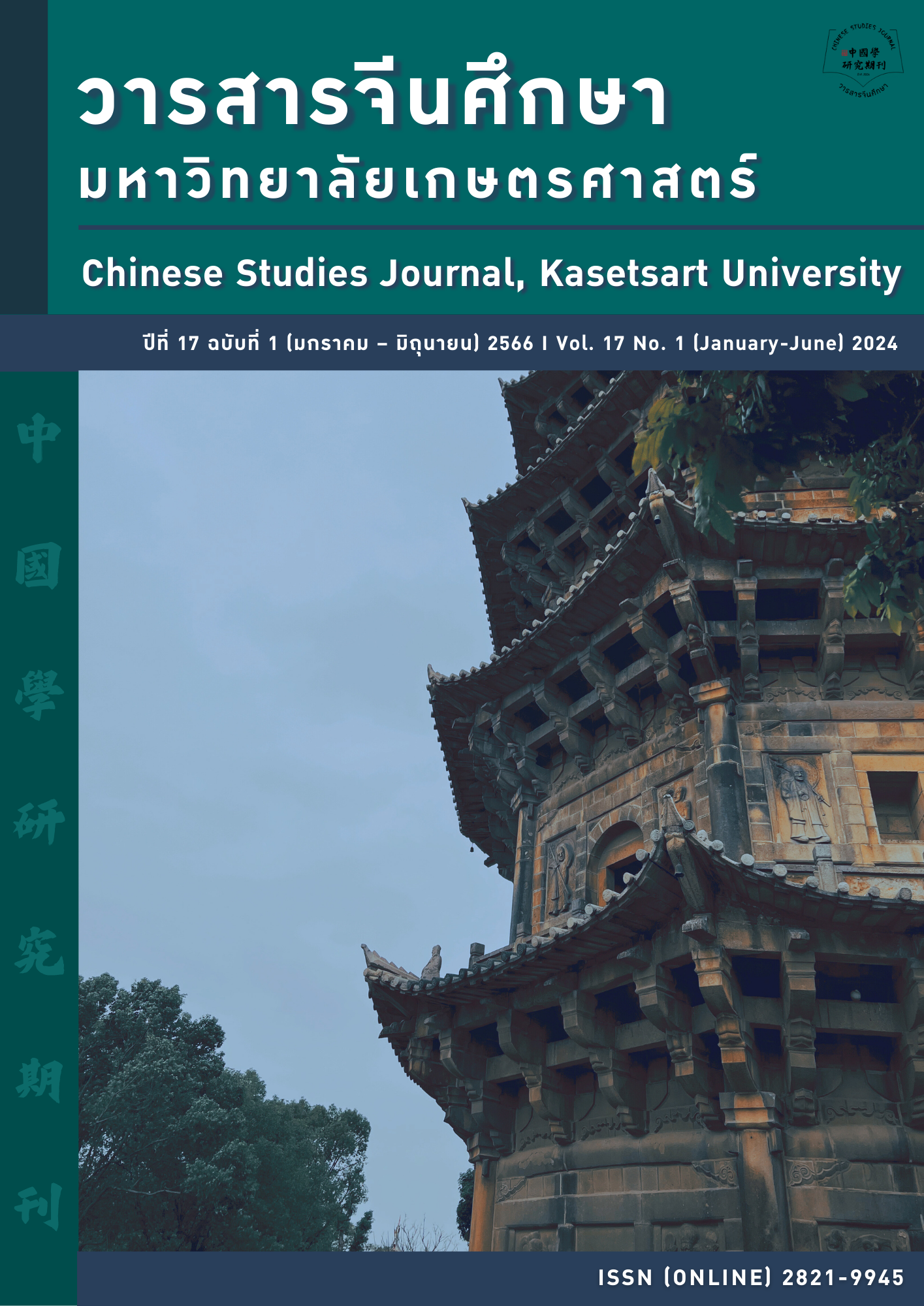The Semantic Entanglement and Quantifier Usage of “Ben”, “Gen”, and “Zhu” การพัวพันเชิงความหมายและการใช้คำลักษณนาม “เปิ่น” “เกิน” และ “จู”
Main Article Content
Abstract
This paper first sorts out and analyses the semantic entanglement of the words “Ben”, “Gen”, and “Zhu” related to the meaning of “tree root” in ancient Chinese and shows that the three are closely related. Specifically, the original meaning of “Ben” is “tree root”, which includes the main part close to the tree root; then, the “Gen” representing the “tree trunk” in the soil and the "Zhu" representing the “tree trunk” on the soil, respectively, replaced the “tree trunk” part of “Ben”, which originally referred to both “tree root” and “tree trunk”, while “Ben” only referred to “tree root”. Subsequently, the “Gen” of the “tree trunk” part in the soil completely gave way to the “Zhu” and took over the meaning of “Ben”. Then paper discusses the usage of quantifiers for the three, and also discusses the usage of quantifiers for “Shu” and “Ke”, all of which are based on corpus retrieval. Regarding the usage of the three quantifiers, this paper shows that “Ben” was first used to measure herbaceous plants, possibly no later than the Pre-Qin period. The “Shu” that emerged later was more active in the Han Dynasty, as its noun meaning was generated only after the emergence of the quantifier meaning, and was replaced by “Zhu” and “Gen” during the Six Dynasties. “Zhu” and “Gen” were mainly used to measure herbaceous plants in the Six Dynasties, and were replaced by “Ke”, which also became the main unit of measurement of woody plants and has been active in modern Chinese.
Article Details

This work is licensed under a Creative Commons Attribution-NonCommercial-NoDerivatives 4.0 International License.
ผลงานทางวิชาการที่ลงตีพิมพ์ในวารสารจีนศึกษา มหาวิทยาลัยเกษตรศาสตร์ เป็นลิขสิทธิ์ของผู้เขียนหรือผู้แปลผลงานนั้น หากนำลงในวารสารจีนศึกษาเป็นครั้งแรก เจ้าของผลงานสามารถนำไปตีพิมพ์ซ้ำในวารสารหรือหนังสืออื่นได้โดยมิต้องแจ้งให้ทราบล่วงหน้า แต่หากผลงานที่ได้รับพิจารณานำลงในวารสารจีนศึกษา เป็นผลงานที่เคยตีพิมพ์ที่อื่นมาก่อนเจ้าของผลงานต้องจัดการเรื่องปัญหาลิขสิทธิ์กับแหล่งพิมพ์แรกเอง หากเกิดปัญหาทางกฎหมาย ถือว่าไม่อยู่ในความรับผิดชอบของวารสารจีนศึกษา มหาวิทยาลัยเกษตรศาสตร์ ทั้งนี้ ความคิดเห็นต่างๆ ในบทความเป็นความคิดเห็นส่วนตัวของผู้เขียน ไม่เกี่ยวกับกองบรรณาธิการวารสารจีนศึกษา มหาวิทยาลัยเกษตรศาสตร์
References
曹瑞芳,李小平.(2022).晋语植物量词“本”的三种读音及用字问题.语言研究,42(1),56-61.
陈明富.(2013).古代涉“树根”义名词历时考察.山东理工大学学报:社会科学版,(6),53-57.
陈明富,张鹏丽.(2011).古代涉“树木”义名词历时考察.殷都学刊,(4),112-117.
陈亦文.(2010).名量词“棵”的历史变迁.汉语史研究集刊,(1),80-98.
陈祝琴 & 岳秀文.(2017).汉语方言量词“兜”的来源与形成.语言研究集刊,(2),279-297, 386-387.
丁福保.(1988).说文解字诂林.北京:中华书局.
崔尔胜.(2009).量词“棵”的发展模式分析.学语文,(5),41-42.
董树人.(1987).关于量词“棵”的出现时间.语言教学与研究,(3),127-127.
董为光.(2003).量词义语义源流三则.中国语文,(5),456-460.
董为光.(2004).汉语词义发展基本类型.武汉:华中科技大学出版社.
何建章.(1990).战国策注释.北京:中华书局.
黄金贵.(1995).古汉语文化词义集类辨考.上海:上海教育出版社.
李计伟.(2009).量词“窠”的产生、发展与量词“棵”的出现.语言科学,(4),431-439.
李计伟.(2010).论量词“根”的形成与其认知语义的多向发展.语文研究,(3),34-38.
李圃.(2002).古文字诂林.上海:上海教育出版社.
李小平.(2012).量词“窠”的产生、演变及其更替.云梦学刊,33(2),136-139.
刘世儒.(1965).魏晋南北朝量词研究.北京:中华书局.
刘彦哲.(2021).汉日源于植物的长条类量词比较研究.华中科技大学.
罗竹风主编.(1986).汉语大字典.北京:汉语大词典出版社.
孟繁杰.(2011).论量词“根”的演变.国际汉语学报,(2),137-146.
史天冠.(2016).现代汉语量词“根”的认知研究.辽宁教育行政学院学报,(4),104-106.
唐苗.(2007).量词“条”与“根”的比较研究.武汉理工大学学报:社会科学版,(4),562-564.
唐钺.(2001).尹文和尹文子.北京:北京大学出版社.
王力等编写.(2000).王力古汉语字典.北京:中华书局.
王念孙.(2004).广雅疏证(附索引).北京:中华书局.
汪维辉.(2000).东汉——隋常用词演变研究.南京:南京大学出版社.
汪小玲 & 李翩.(2009).个体量词的产生及其历史演变过程探析——以量词“本”为例.钦州学院
学报,(2),95-97,118.
王晓燕.(2022).量词“根”的词典释义探讨.辞书研究,(2),48-54.
詹卫东,郭锐,谌贻荣.(2021).北京大学中国语言学研究中心.CCL语料库,
http://ccl.pku.edu.cn:8080/ccl_corpus
许慎撰,徐铉校定.(2012).说文解字附检字.北京:中华书局.
张鹏丽,陈明富.(2012).古代“树木”个体量词历时考察.北方论丛,(1),59-63.


